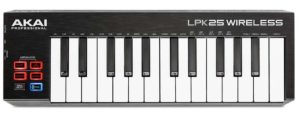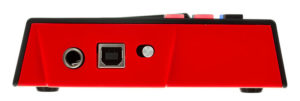Back in 2016, AKAI refreshed their portable midi controller lineup (LPK 25 & LPD 8) with new advanced features and completely re-designed. Both MIDI controllers have been on the market for many years now and are still a popular companion with hobby as well as professional musicians. Also I use longer time an LPK-25 as mobile keyboard and was until the moment where it no longer works very satisfied with it. Here you have to say, it has worked for several years without problems. Since in this time not many mobile keyboards for this price was on the market and since I myself was very satisfied with it, I have recommended many musicians this instrument.
I had the chance to check out the new wireless version of the LPK25 for several weeks. In short: I don’t regret that I was for a few weeks again an LPK25 keyboard user.

Introduction
The LPK25 Wireless is a further development of the best known LPK 25 keyboard from AKAI. It features same as the first version, a 25 keys MIDI velocity-sensitive keyboard in a nice plastic build case.

As you can see, the design is simple but changes quite a lot compared to the previous version. The front is still in simple black with white labels. It looks different on the left, right and beneath. Here dominates now the colour red which fit very well to the new improved design. The connection side remains unchanged on the left side and has been expanded with various helpful features.

USB Connection
Compared to the old LPK25, the new version doesn’t include a micro USB anymore but a classical USB B port. In my opinion, this is the right decision from the AKAI developers because the old micro USB connection was quite unstable and went quickly broken. It makes the device not thinner but more robust in the connection.

Left beside the USB, you can find now a connection for sustain pedals which was not present in the previous version. This a great new features because it gives musicians more space for mobile creativity and it’s now more playable like a bigger keyboard. Right next to the USB port, you can find the biggest innovation for this new release.The new version features Bluetooth MIDI support that allows users to play instruments wirelessly everywhere. Musicians have here the possibility to switch to USB powered so the keyboard is powered by your PC/Mac or iOS device or you can activate the Bluetooth connection. This features requires three double A batteries or rechargeable batteries.

If the device is used daily, I would advise you to rechargeable batteries. These can be recharged in the evening after your jam or day in the studio and on the next day, you have again full power for making music. One little downside, you must open the backside for removing and recharging them. An internal charging system is here not available.
Bluetooth connection
The new Bluetooth connection behave nice and doesn’t make major problems. Per example, I have the new Yonac KASAPR Synth mainly played with this keyboard over bluetooth.To connect the keyboard to an iOS app per example, you simply press the pair bluetooth button and your device will be available inside the settings of your app. Important here: not all the iOS music apps support midi over bluetooth, only apps with this technology works fine over bluetooth with this keyboard. If the app doesn’t feature it, you can always switch to the USB cable again. What I have noticed is, that there is still a little latency between keyboard and instrument when you use it wirelessly. It’s depends very how do you use it and with which apps or programs. It’s playable but although the USB connection is here cleaner and better.
Also I noticed something else with the Bluetooth transmission. The arpeggiator function in this keyboard is a super additional features but in the Bluetooth mode it is unfortunately not controllable by an external clock. This is where the MIDI over Bluetooth protocol stands in the way which doesn’t allow yet this.

I don’t understand the lack of DIN midi these days. How much can it really add to the cost considering MidiPlus can come out with a 2×2 USB midi interface for $20 retail?
It’s a very low budget keyboard for 69€ and can understand the developers that they includes it only to higher prices keyboards.So they can split their keyboard range in different target audiences. If every keyboard comes with everything onboard, it doesn’t make sense to make different products. In this case, they have for all customers (low budget, higher low budget…) a keyboard. It’s not great but it’s more a marketing/segmentation decision.
How are you able to connect the keyboard wireless to Logic X? I am able to enable Bluetooth via Audio-MIDI Setup, and then press “Apply” on the LPK window that I opened from witin MIDI Studio. Still, I can’t find a way to get Logic to add it. Thanks!